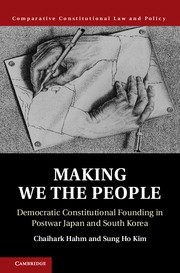Book contents
- Making We the People
- Comparative Constitutional Law and Policy
- Making We the People
- Copyright page
- Dedication
- Contents
- Book part
- Introduction
- 1 The Unbearable Lightness of the People
- 2 War and Peace
- 3 The Ghost of Empire Past
- 4 A Room of One’s Own
- Conclusion
- Note on Romanization and Sources
- Bibliography
- Glossary
- Index
- References
Bibliography
Published online by Cambridge University Press: 05 December 2015
- Making We the People
- Comparative Constitutional Law and Policy
- Making We the People
- Copyright page
- Dedication
- Contents
- Book part
- Introduction
- 1 The Unbearable Lightness of the People
- 2 War and Peace
- 3 The Ghost of Empire Past
- 4 A Room of One’s Own
- Conclusion
- Note on Romanization and Sources
- Bibliography
- Glossary
- Index
- References
- Type
- Chapter
- Information
- Making We the PeopleDemocratic Constitutional Founding in Postwar Japan and South Korea, pp. 289 - 304Publisher: Cambridge University PressPrint publication year: 2015



